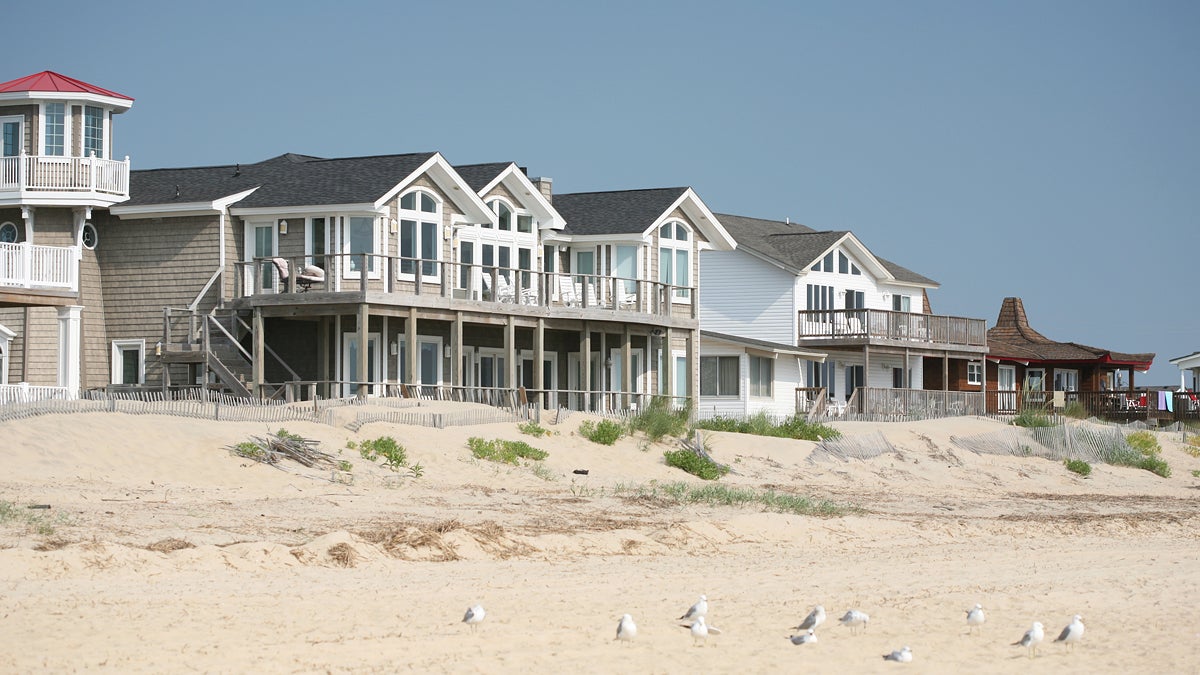The Shore After Sandy — Approach 2: Rethink and Adapt

Living close to the ocean creates a financial risk to the homeowner and the community. (Photo from Shutterstock)
The community dialogues called “Ready for Next Time? Rethinking the Shore After Sandy” use an issue guide devised by WHYY and the Penn Project for Civic Engagement.
This discussion framework takes the many ideas, arguments and debates going on right now and organizes them into three general approaches or perspectives: 1) Rebuild and Prepare 2) Rethink and Adapt 3) Restore and Retreat.
Today, NewsWorks presents the second of those approaches in detail:
THE OVERALL CHALLENGE
At the regional, state, community and individual levels, our economic and emotional investment in the Shore is huge. But the evidence of Irene and Sandy suggests that storms of hurricane force will hit the Shore again, threatening major damage and loss of life. Views diverge on what changes in Shore development patterns and habits need to happen to respond to this threat.
APPROACH 2 – RETHINK AND ADAPT
Our economic and emotional investments in the shore are indeed deep, but simply rebuilding the Shore the way it was puts them at needless risk. We can’t count on the nation’s taxpayers to come to our aid again, especially if we show we’ve learned nothing from this storm. Through smart regional planning, we can mitigate risk while preserving most of what we love about the Shore, including its economic vitality.
We must accept that in some areas it is folly to rebuild – or at least to rebuild in the same way. Individual property owners don’t have an unlimited right to do whatever they want, if their actions put the rest of the community at risk. And we can learn a lot from how oceanfront communities elsewhere have changed development patterns, building codes and infrastructure to limit harm from hurricanes.
PROPONENTS TEND TO FAVOR THESE ACTIONS:
Rebuild and expand dunes for flood protection. Pay for the local share of the work through assessments based on property values.
With inclusive public input, create an enforceable master plan for Shore counties that bars development in high-risk areas, and shapes it in others.
Create a regional planning agency with power to enforce the plan, and ensure its members represent a cross-section of interests.
Base the master plan upon sound evidence about sea level rise.
Identify the developed oceanfront areas that represent so much economic value and sunken investment they must be rebuilt. Focus limited government dollars on improving storm protection in those places.
Compensate owners whose property is deemed unfit for rebuilding.
Learn best practices from southern coastal areas on how to build more storm-resilient communities.
ARGUMENTS IN FAVOR OF THIS APPROACH:
Patterns of damage from Sandy teach how dramatically the choices made by one property owner can adversely others, even several communities away.
One size never fits all. A rebuilding plan that makes sense in one community might make less sense in another.
A short-term focus on “getting ready for the summer” can lead to unwise decisions that will bring long-term costs.
Southern communities that endure frequent hurricanes can teach us some sound principles for living adaptively at ocean’s edge.
With all its other needs, the state of New Jersey can’t afford to insulate Shore property owners from all risks of building near the ocean (i.e. “moral hazard”).
The nation’s taxpayers will rebel against helping New Jersey if another major storm reveals we did little to limit the risks of how we build.
The best use of storm aid is to finance smart adaptations that will reduce the need for massive recovery costs in the future.
The storms showed the limits of Jersey’s beloved local control. Storm damage has complex causes that transcend municipal boundaries. Smart, long-range planning is the path to a safer, more sustainable Shore.
It’s fair to tax all members of a community for steps (e.g. dune replenishment or clearing of no-build zones) that benefit the safety and property values of the whole community.
Resiliency does not mean repeating mistakes. It means smart choices.
ARGUMENTS AGAINST THIS APPROACH:
Regional planning produces red tape and unfunded mandates.
The Shore is a place of business critical to the state’s economy. Unelected planners should not trump the market-driven decisions of businesspeople.
With what money and by what formula will you compensate people whose family homes and businesses are wiped out by the dictates of a regional plan?
Overreaction is costly, too. New Jersey is not Florida. Hurricanes will remain rare here.
New Jersey ranks No. 4 national in federal taxes paid per capita, while ranking dead last in the amount of Federal taxes returned to the state, per person. For years, we’ve paid to help other Americans recover from storms, floods, fires, twisters and quakes. And we don’t tell them how to live; we just send aid. Why shouldn’t we get the same consideration?
This approach favors a set of halfway measures that will do little to counter the long-term impact of sea-level rise and climate change.
This approach will do too little to protect the Shore’s ecologies and species against damage from overdevelopment.
Dune rebuilding is a futile defense of elite property, given the ocean’s power to reshape barrier islands. This approach, whether intentionally or not, will accelerate the trend of the Shore being accessible only to the rich.
This issue guide was prepared with input from WHYY/NewsWorks partners in this dialogue project, including Creative New Jersey, Sustainable Jersey, Citizens Campaign and Jersey Shore Hurricane News.
WHYY is your source for fact-based, in-depth journalism and information. As a nonprofit organization, we rely on financial support from readers like you. Please give today.




